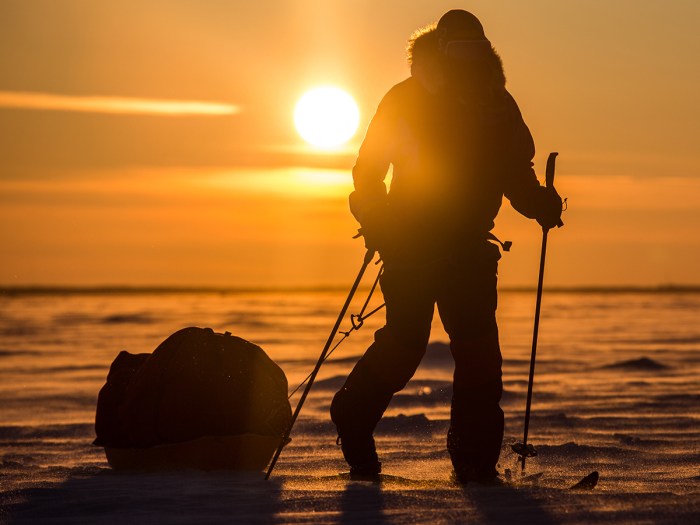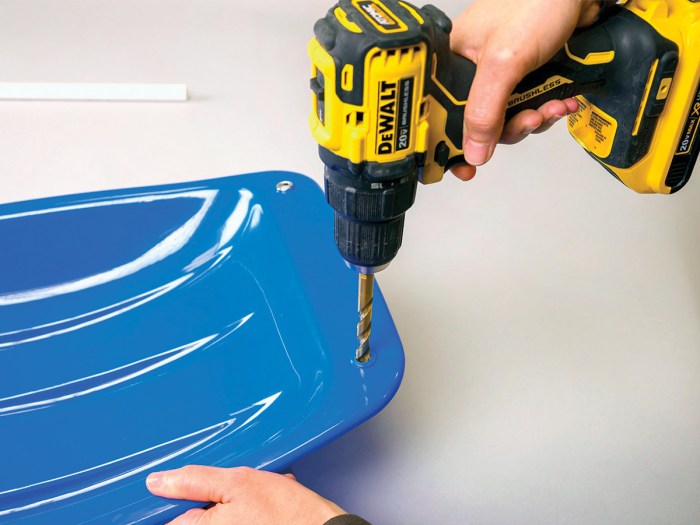How to Use a Sled to Make a Pulk for Backpacking in the Snow

Sledding is a super-fun winter activity, but you can do more with your sled than race downhill. Some sleds can make winter backpacking easier by helping haul your gear.
Polar explorer Eric Larsen, who has trekked to the north pole many times, says carrying gear in a sled or “pulk” is more efficient than carrying gear on your back.

“Not only do you not get as sweaty when you’re pulling your gear instead of carrying it,” Larsen tells SL, “but it’s easier to manage moisture and adjust layers.”
HOW TO MAKE A PULK
It’s easy to make any toboggan-style plastic sled part of your winter camping kit.

Step 1. Start with an inexpensive plastic kit. Drill holes (or ask a parent for help drilling holes) in the front rim so you can attach a rope on either side of the front of the sled. Reinforce the holes with metal hardware for durability.

Step 2. Then set up your tow ropes. Thread a rope through the holes on each side of the front rim of the sled.
If you’ll be traveling on uneven terrain, thread your ropes through a section of narrow PVC pipe — one piece of pipe per side. The PVC pipe helps give you the best control.
Finally, tie the end of each piece of rope to a carabiner. You can clip those carabiners to the waistbelt of your pack when you’re ready to tow the sled.

Step 3. For added control, cross your ropes when you attach them to your pack. Make sure the ropes are long enough so you’re not kicking the sled with your skis or snowshoes.
Larsen likes to make his sled ropes long enough so he can walk back to the sled without detaching it from his pack. He uses butterfly knots to make the rope sections longer or shorter. To learn how to tie this knot, visit go.scoutlife.org/butterflyknot or watch the video below.
Larsen also recommends that you don’t tie your sled to the back of your pack: “Make a bridle, and clip your sled rope carabiners near your hips where your pack’s load lifters come in so that you’re pulling with your center of gravity.”

HOW TO PACK YOUR BACKPACKING SLED
Sledding with your gear is less strenuous than carrying it, but it’s still possible to overdo it. Make good choices about what to bring, especially since you’re also weighed down with extra clothing to stay warm.

When packing your sled, distribute the weight to keep the sled stable and balanced. Put the heaviest gear on the bottom and toward the back. Put your lightest gear in the front. Larsen likes to keep extra mitts, goggles, an extra layer of clothes, water and snacks in a small bag at the front of the sled so he can get to them easily.
If you have access to a waterproof duffel, pack your gear in that. If not, pack your gear in heavy-duty contractor bags inside any duffel bag. Keep any gear you want to be able to access during the day in a daypack or small duffel, and secure both bags to the sled. Once your sled is loaded, wrap a tarp over your duffels to protect everything from the weather. Lace bungees or cord across the sled to secure your gear.

When you get to camp, you can use the tarp on the snow-covered ground to keep everything dry when you’re unloading. And when you’re on the trail, you can use your loaded sled as a chair when you take a break. If you have on skis, you can unclip yourself from your sled and back up — with a ski on either side of the sled — so you won’t have to take off your skis to take a rest. If you opt not to use PVC pipe, like Larsen, you won’t need to unclip.

RECOMMENDED SLEDS FOR FUN AND WINTER HIKING
“When it comes to backpacking sleds, the inexpensive solution is actually the best solution,” Larsen says. “A cheap sled will be light, easy to use and also fun when you get to camp.”

Strap a SUPERIO ROUND SNOW SLED ($20, superiobrand.com) to the outside of your pack, and when you get to an open hill, slip it off and hop on for a ride. The sled measures 24 inches across and is made with heavy-duty plastic. It also has hand grips on either side so you can hold on as you zip downhill. Superio also makes another round sled with elevated handles for $26.

To tow your gear, you’ll need a toboggan-style sled like the ERA GROUP EXPEDITION PRO UTILITY SLED ($70, eragroup.ca). This sled is designed for pulling gear, not for sliding. Its heavy-duty polyethylene plastic weighs just 5 pounds and comes with reinforced grommets. At 5 feet long and almost 2 feet across, you should be able to pack a lot of gear.

A cheaper sled can work just as well, like the FROST RUSH LARGE TOBOGGAN SLED ($30, machrus.com). It comes with predrilled holes for tow ropes and cutout handles that can be used to tie down gear. It has a slick bottom to help you glide across the snow as you ride on it.
GUIDE TO SAFE SLEDDING
When you go sledding, make sure the hill is safe and free of obstacles like rocks and trees. Even if the hill doesn’t have any obstacles, still wear a helmet. Have two separate paths: one for sledding down and one for walking back up.
For more info on winter sports safety, visit go.scoutlife.org/wintersports
Does The Backpackung pulk come complete with an Alaskan Malamute Sled Dog, a huskie Sled dog, a Grey Wolf Timber Wolf Sled dog, a Saint Bernard Dog complete with a coffee thermos dog collar, a hot chocolate thermos collar, a lenon-lime green Colored gatorade thermos collar, and a drinking water tankard thermos collar…….or a Black labrador Retriever dog, a yellow labrador Retriever dog, a Chocolate labrador Retriever, a Chesapeake Bay Retriever, a Golden Retriever.,…..or just The Members of my Patrol in my Noy Scout Troop?
I bought an old backpack from the goodwill store, removed the belt, and then used it as part of the harness.
I found that if you crossed the poles to your sled before you tied it to your waist the sled was more stable and would track behind you better.
I like it but could you try to make the sled a lot lighter in weight
I would try to take the mettle out of the frame of an OLD backpacking pack and use it for the sled body!
Sounds awsome gu’na build it , I need my dad to take me to the hardware store
That’s a good idea for cross-country skiing. I’m going to try it for a campout in a few weeks.
i would make one of these but i live in florida and we dont get any snow so i will biuld one one wheels
Otter, if there was no snow then you would not use it!
WHAT IF THERE WAS NO SNOW ON THE MOUNTAINES
open a door
I will try that for ice fishing
Cool, I ice fish and it would be a great idea!
hey marine! this would not work for me, I live in hot places d00d!
Well, Collector of chickens, the mountains are usually rocky and very steep!
Question……Why wouldn’t it work in the mountains?..There is
plenty of snow way up there!
Great idea, but probably doesn’t work in the mountains where its most needed!
Hey I like this idea I think it would work best in the snow thiugh.
i made one of these at a Spring Campreee